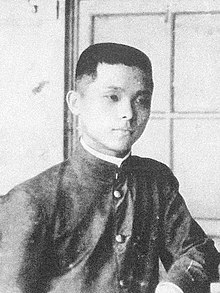Huang Tushui
Huang Tushui ( Chinese 黃土 水 Huáng Tǔshuǐ , Pe̍h-ōe-jī N̂g Thóo-Suí ) (born July 3, 1895 in Mengjia , today: Wanhua , Taiwan ; † December 21, 1930 in Tokyo ) was a Taiwanese sculptor at the time of the Japanese Rule over Taiwan .
Life
Huang Tushui was born in one of the oldest districts of Taipei shortly after the beginning of Japanese rule. He learned his first manual skills from his father, a rickshaw maker . He also grew up in close proximity to the Longshan Temple , with whose traditional carvings he was familiar from childhood. Huang belonged to the first generation to go through the modern school system introduced by the Japanese. After attending elementary school (1906–1911) and middle school (1911–1915), he was the first Taiwanese to study at the School of Fine Arts in Tokyo (today's Tokyo Art School ), where he graduated in 1920.
Huang achieved fame both in Japan and in his home country when his sculpture The Boy Playing the Flute (made in 1918) was included in the prestigious Imperial Exhibition of 1920. He was the first Taiwanese to take part in this exhibition. Further works by Huang were added to the list in 1921, 1922 and 1924.
Huang, married since 1923, lived after his studies as a freelance artist in Tokyo, where he had his own studio. However, he regularly visited his native Taiwan. His fame earned him contracts from both private and public sources. In 1928 he portrayed the in-laws of Emperor Hirohito and, on behalf of the city of Taipei, made the sculpture Auf dem Heimweg (歸途 Guitu) as a gift on the occasion of Hirohito's coronation.
Unlike a number of other Taiwanese artists of the era, Huang was not involved in social movements and hardly in cultural associations. He developed peritonitis in late 1930 and died on December 21 at the age of 35 in Tokyo. He was buried in his native Taipei. The following year, a memorial exhibition was held in his honor in Taipei.
plant
Familiar with traditional Taiwanese carving from a young age, Huang learned a modern style influenced by Western art while studying in Tokyo, which includes the works that were included in the Imperial Exhibition and made Huang famous. During the last decade of his life, the focus of his work shifted more and more towards local Taiwanese motifs, with Huang showing a particular fondness for depicting water buffalo , a symbol of rural Taiwan, and fusing the modern Western style with traditional Chinese elements.
His most famous works include:
- Li Tieguai (李鐵 拐, 1915), wooden figure in traditional style, depicting the Daoist immortal Li Tieguai , now privately owned.
- The boy playing the flute (山 童 吹笛 Shantong chui di, 1918), plaster figure, original lost today. Included in the Imperial Exhibition in 1920.
- Sweet dew (甘露 水 Ganlushui, 1919), marble figure, original lost today. Included in the 1921 Imperial Exhibition .
- Bust of a girl (女孩 胸像 Nühai xiongxiang, 1920), gift from the artist to his old elementary school (today: Taiping Elementary School in Taipei), kept there to this day.
- Woman posing (擺 姿勢 的 女人 Bai zishi de nüren, 1922), original missing today. Included in the 1922 Imperial Exhibition .
- Mikado pheasant and sika deer (帝雉 、 華 鹿 Dizhi hualu, 1922), gift to the Japanese imperial family, today kept in the Imperial Court Office of Tokyo.
- In the country (郊外 Jiaowai, 1924), bronze sculpture of a water buffalo with two herons, original lost today. Included in the 1924 Imperial Exhibition .
- In the south (南國 的 風情 Nanguo de fengqing, 1927). Relief of a herd of water buffalo, original lost today.
- The Buddha comes from the mountains (釋迦 出山 Shijia chu shan, 1927). Wooden sculpture made for the Longshan Temple in Taipei, depicting Siddharta Gautama . Destroyed in an air raid in World War II, later reconstructed using the remaining plaster draft. Copies are now in the National Art Museum of Taiwan , the Municipal Art Museum Taipei , the Municipal Art Museum Kaohsiung , the National History Museum in Taipei, the Longshan Temple (Taipei), the Kaiyuan Temple (Tainan) and privately owned by the family of the artist.
- Bust portrait of Prince Kuni Kuniyoshi and his wife (久 邇 宮 邦彥 親王 夫婦 像 Jiuer Gong Bangyan fufu xiang, 1928). Owned by the Japanese imperial family
- The water buffalo (水牛 群像 Shuiniu qunxiang, 1930), plaster relief, the artist's last and most famous work, awarded as the National Treasure of the Republic of China . The original is located in the Zhongshan Hall in Taipei, copies in the National Art Museum of Taiwan , the Municipal Art Museum Taipei (bronze casting) and the Municipal Art Museum Kaohsiung (bronze casting).
literature
- Li Chin-Hsien (李欽 賢): 台灣 再現 (Volume 89): 人物 ── 黃土 水Taiwan zaixian (Volume 89): Renwu - Huang Tushui (Taiwan in retrospect (Volume 89): People - Huang Tushui), 莎士比亞 文化 事業 Shashibiya wenhua shiye, Taichung 2009
Individual evidence
Web links
- Biography and works of Huang Tushuis, website of the Taiwanese Ministry of Culture (Chinese and English)
- Diana Lin: Pioneering Taiwan artist Huang Tu-shui advances sculpture from temple craft to realm of the fine arts , Taiwan Today, March 28, 1996
- Tseng Wei-chen, Jake Chung: Historically significant statue heads back to Taiwan , Taipei Times, November 4, 2013
| personal data | |
|---|---|
| SURNAME | Huang, Tushui |
| ALTERNATIVE NAMES | Huang Tu-shui |
| BRIEF DESCRIPTION | Taiwanese sculptor |
| DATE OF BIRTH | July 3, 1895 |
| PLACE OF BIRTH | Taipei , Taiwan |
| DATE OF DEATH | December 21, 1930 |
| Place of death | Tokyo , Japan |


